一、数据模型
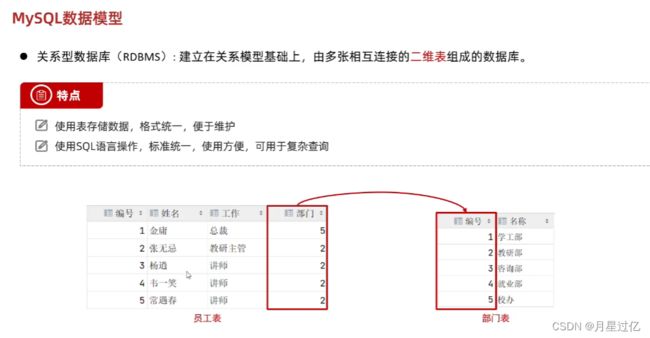
二、SQL简介
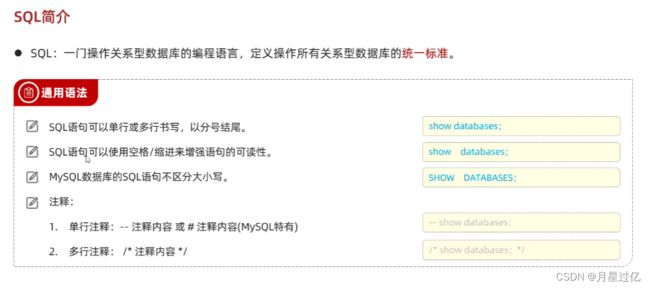

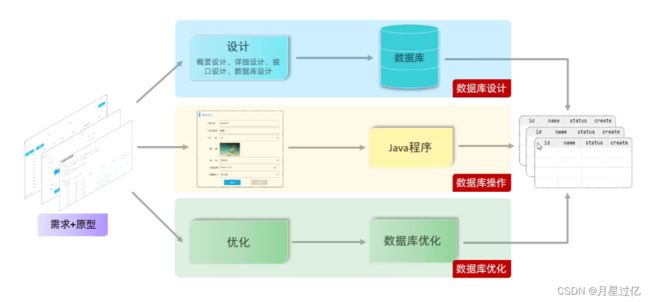
三、数据定义语言-DDL
1.DDL操作数据库


2.DDL-操作表结构
1.创建

create table db_user(
id int comment 'id',
username varchar(20) comment '姓名',
age int comment '年龄',
gender char(1) comment '性别'
)comment '用户表'
-----------------------------------------------------------------------------
create table db_user(
id int primary key auto_increment comment 'id',
username varchar(20) not null unique comment '姓名',
name varchar(20) not null ,
age int comment '年龄',
gender char(1) default '男' comment '性别'
)comment '用户表'
2.数据类型
1.数值类型

2.字符串类型
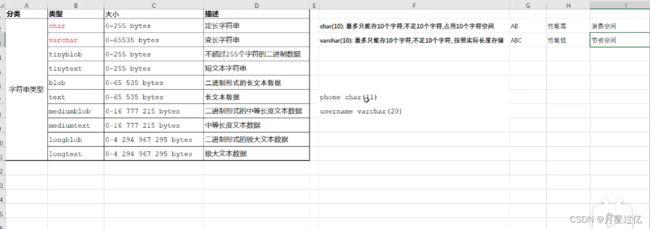
3.日期,时间类型

CREATE TABLE `tb_emp` (
`id` int NOT NULL AUTO_INCREMENT COMMENT '主键ID\n',
`username` varchar(20) NOT NULL COMMENT '用户名',
`password` varchar(32) DEFAULT '123456' COMMENT '密码',
`name` varchar(10) NOT NULL COMMENT '姓名',
`column_5` int DEFAULT NULL,
`gender` tinyint unsigned NOT NULL DEFAULT '1' COMMENT '性别 1:男 2:女',
`img` varchar(300) DEFAULT NULL COMMENT '图像的URL',
`job` tinyint unsigned DEFAULT NULL COMMENT '职位 1.总经理 2.主管 3.经理 4.职员',
`entrydate` date DEFAULT NULL COMMENT '入职日期',
`create_time` datetime NOT NULL COMMENT '创建时间',
`update_time` datetime NOT NULL COMMENT '修改时间',
PRIMARY KEY (`id`),
UNIQUE KEY `tb_emp_username_uindex` (`username`)
) ENGINE=InnoDB DEFAULT CHARSET=utf8mb4 COLLATE=utf8mb4_0900_ai_ci

3.表操作
1.查询
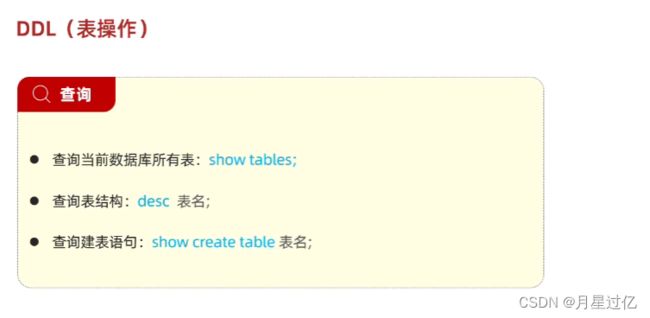
2.修改
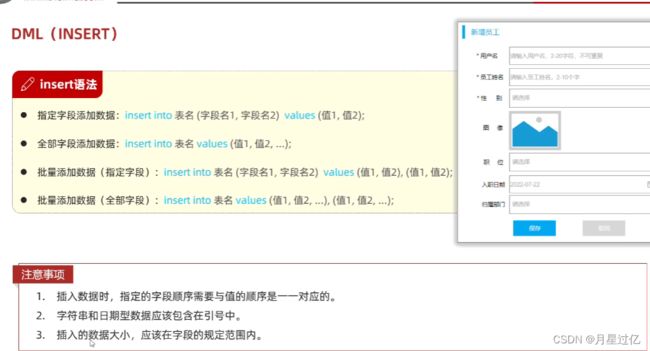
alter table tb_emp add qq varchar(10) comment 'QQ';
alter table tb_emp modify qq varchar(13) comment 'QQ';
alter table tb_emp change qq qq_num varchar(13) comment 'QQ';
alter table tb_emp drop column qq_num;
rename table tb_emp
3.删除
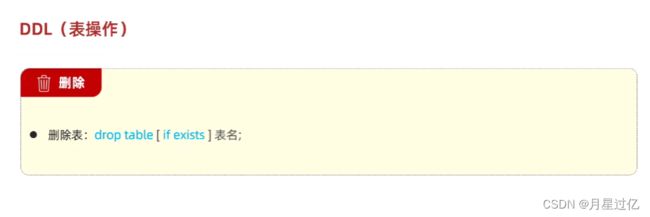
四、数据操作语言-DML

1.INSERT 添加数据

insert into emp (username,name,gender,create_time,update_time) values ('wuji','张无忌','1',now(),now());
insert into emp (id, username, password, name, gender, img, job, entrydate, create_time, update_time)
values (2,'zhiruo','123','周芷若',2,'1.jpg',1,'2010-01-01',now(),now());
insert into emp
values (3,'zhiruo2','123','周芷若',2,'1.jpg',1,'2010-01-01',now(),now());
insert into emp (username,name,gender,create_time,update_time) values ('weiyixiao','韦一笑','1',now(),now()),('wanghuifan','王哥','1',now(),now());
2.修改数据(更新)
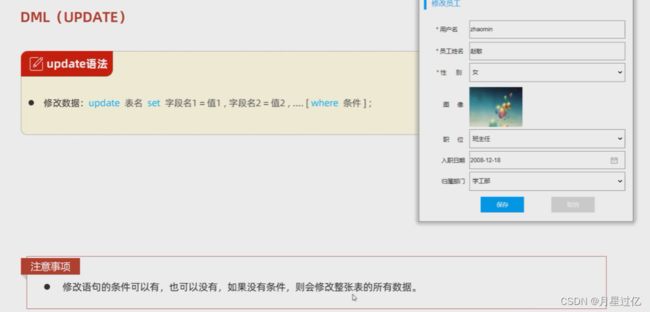
update emp set name='张四',update_time=now() where id=1;
update emp set entrydate='2010-01-01',update_time=now() ;
3.删除数据
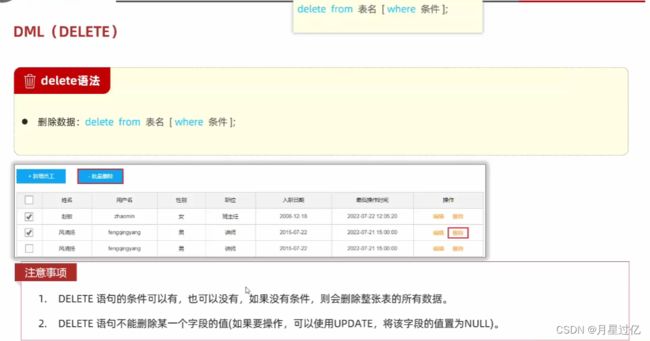
delete from emp where id=1;
delete from db_emp ;

五、数据查询语言-DQL

1.基本查询

select * from tb_emp;
select name as '姓名',entrydate as '入职日期' from tb_emp;
select name '姓名',entrydate '入职日期' from tb_emp;
select distinct job from tb_emp;
2.条件查询

select name,entrydate from tb_emp;
select id, username, password, name, gender, image, job, entrydate, create_time, update_time from tb_emp;
select * from tb_emp;
select name as '姓名',entrydate as '入职日期' from tb_emp;
select name '姓名',entrydate '入职日期' from tb_emp;
select distinct job from tb_emp;
select * from tb_emp where name='杨逍';
select * from tb_emp where id<=5;
select * from tb_emp where job is null;
select * from tb_emp where job is not null;
select * from tb_emp where password !='123456';
select * from tb_emp where entrydate between '2000-01-01' and '2010-01-01';
select * from tb_emp where entrydate>='2000-01-01' and entrydate<='2010-01-01';
select * from tb_emp where entrydate between '2000-01-01' and '2010-01-01' and gender=2;
select * from tb_emp where job=2 or job=3 or job=4;
select * from tb_emp where job in (2,3,4);
select * from tb_emp where name like '__';
select * from tb_emp where name like '张%';
3.聚合函数

-- 1.统计该企业员工的数量 -- count
-- A.count(字段)
select count(id) from tb_emp;
-- B.count(常量)
select count(0) from tb_emp;
-- C.count(*)
select count(*) from tb_emp;
-- 2.统计该企业最早入职的员工
select min(entrydate) from tb_emp;
-- 3.统计该企业最迟入职的员工
select max(entrydate) from tb_emp;
-- 4.统计该企业员工ID的平均值
select avg(id) from tb_emp;
-- 5.统计该企业员工ID的和
select sum(id) from tb_emp;
4.分组查询
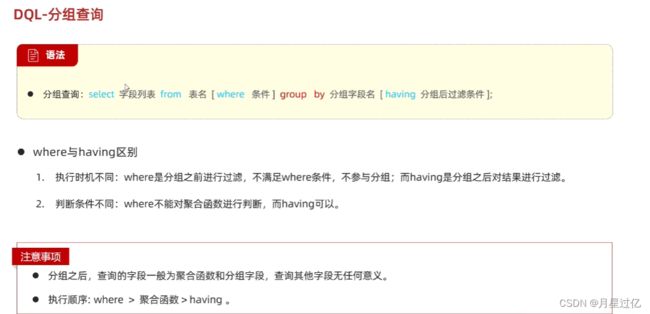
-- 分组后select 只能返回 分组字段 和聚合函数
select gender,count(*) from tb_emp group by gender;
select job,count(*) as job_num from tb_emp where entrydate<='2015-01-01' group by job having job_num>=2;
5.排序查询
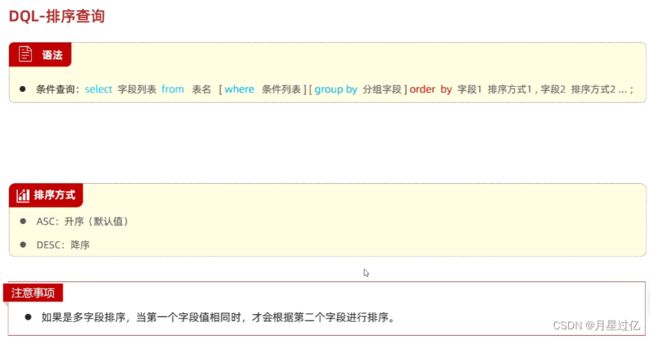
select * from tb_emp order by entrydate;
select * from tb_emp order by entrydate desc ;
-- 根据入职时间 对公司的员工进行升序排序 ,入职时间相同 ,在按照更新时间进行降序排序
select * from tb_emp order by entrydate,update_time desc ;
6.分页查询

-- 1. 从起始索引为 0开始 查询员工数据,分页展示5条记录
select * from tb_emp limit 0,5;
-- 2.长训 第一页员工数据,每层展示5条记录
select * from tb_emp limit 0,5;
-- 3.查询第二页 员工数据 ,每页展示5 条
select * from tb_emp limit 5,5;
-- 4.查询第三页 员工数据 ,每页展示五条
select * from tb_emp limit 10,5;
-- 起始索引计算公式 (页码-1)*每页所展示的记录数
select * from tb_emp where name like '张%' and gender=1 and entrydate between '2000-01-01' and '2015-12-31' order by update_time desc limit 0,10;
7.流程控制函数
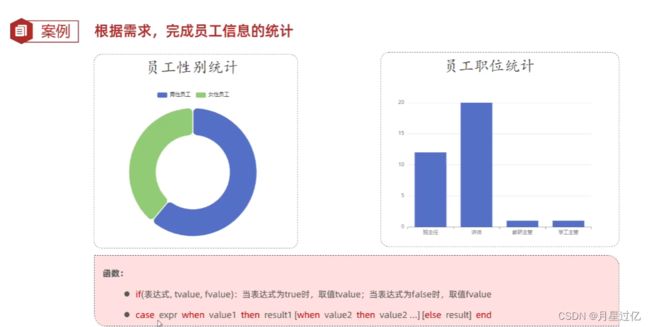
select * from tb_emp where name like '张%' and gender=1 and entrydate between '2000-01-01' and '2015-12-31' order by update_time desc limit 0,10;
-- if(条件表达式,true 取值 ,false 取值)
select if(gender=1,'男性员工','女性员工')as'性别', gender ,count(*) from tb_emp group by gender;
-- case表达式 when 值1 then 结果1 ,when 值2 then 结果2...else ...end
select
( case job when 1 then '班主任' when 2 then'讲师' when 3 then '学工主管' when 4 then '教研主管'else '未分配职位' end) as '职位'
,job,count(*) from tb_emp group by job;
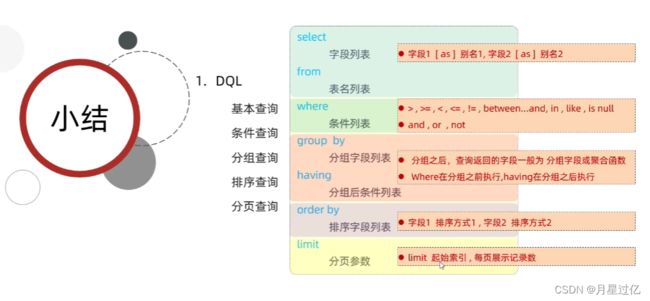
六、多表关系
1.一对多
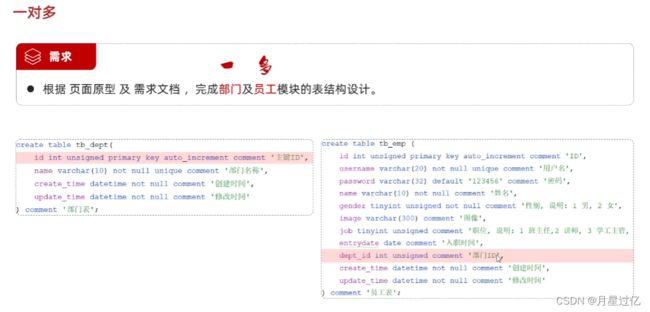
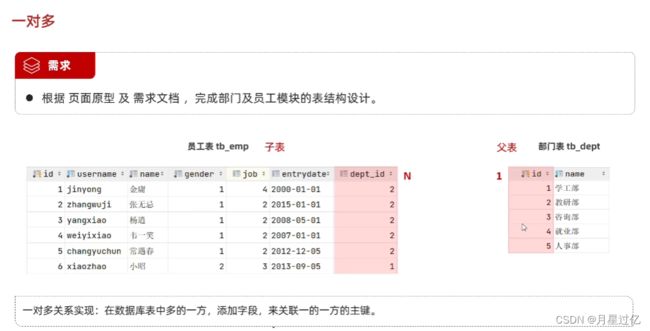
create table tb_emp (
id int unsigned primary key auto_increment comment 'ID',
username varchar(20) not null unique comment '用户名',
password varchar(32) default '123456' comment '密码',
name varchar(10) not null comment '姓名',
gender tinyint unsigned not null comment '性别, 说明: 1 男, 2 女',
image varchar(300) comment '图像',
job tinyint unsigned comment '职位, 说明: 1 班主任,2 讲师, 3 学工主管, 4 教研主管',
entrydate date comment '入职时间',
dept_id int unsigned ,
create_time datetime not null comment '创建时间',
update_time datetime not null comment '修改时间'
) comment '员工表';
create table tb_dept(
id int unsigned primary key auto_increment,
name varchar(10) not null unique,
create_time datetime not null comment '创建时间',
update_time datetime not null comment '修改时间'
)
2.一对多-外键

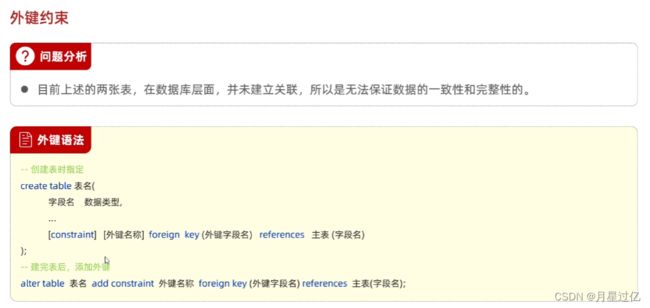
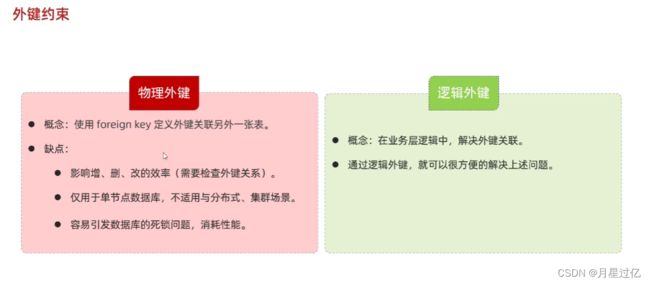
3.一对一

-- ===========================================一对一=====================================
create table tb_user(
id int unsigned primary key auto_increment comment 'ID',
name varchar(10) not null comment '姓名',
gender tinyint unsigned not null comment '性别, 1 男 2 女',
phone char(11) comment '手机号',
degree varchar(10) comment '学历'
) comment '用户信息表';
insert into tb_user values (1,'白眉鹰王',1,'18812340001','初中'),
(2,'青翼蝠王',1,'18812340002','大专'),
(3,'金毛狮王',1,'18812340003','初中'),
(4,'紫衫龙王',2,'18812340004','硕士');
create table tb_user_card(
id int unsigned primary key auto_increment comment 'ID',
nationality varchar(10) not null comment '民族',
birthday date not null comment '生日',
idcard char(18) not null comment '身份证号',
issued varchar(20) not null comment '签发机关',
expire_begin date not null comment '有效期限-开始',
expire_end date comment '有效期限-结束',
user_id int unsigned not null unique comment '用户ID',
constraint fk_user_id foreign key (user_id) references tb_user(id)
) comment '用户信息表';
insert into tb_user_card values (1,'汉','1960-11-06','100000100000100001','朝阳区公安局','2000-06-10',null,1),
(2,'汉','1971-11-06','100000100000100002','静安区公安局','2005-06-10','2025-06-10',2),
(3,'汉','1963-11-06','100000100000100003','昌平区公安局','2006-06-10',null,3),
(4,'回','1980-11-06','100000100000100004','海淀区公安局','2008-06-10','2028-06-10',4);
4.多对多

-- ======================================多对多=============================
create table tb_student(
id int auto_increment primary key comment '主键ID',
name varchar(10) comment '姓名',
no varchar(10) comment '学号'
) comment '学生表';
insert into tb_student(name, no) values ('黛绮丝', '2000100101'),('谢逊', '2000100102'),('殷天正', '2000100103'),('韦一笑', '2000100104');
create table tb_course(
id int auto_increment primary key comment '主键ID',
name varchar(10) comment '课程名称'
) comment '课程表';
insert into tb_course (name) values ('Java'), ('PHP'), ('MySQL') , ('Hadoop');
create table tb_student_course(
id int auto_increment comment '主键' primary key,
student_id int not null comment '学生ID',
course_id int not null comment '课程ID',
constraint fk_courseid foreign key (course_id) references tb_course (id),
constraint fk_studentid foreign key (student_id) references tb_student (id)
)comment '学生课程中间表';
insert into tb_student_course(student_id, course_id) values (1,1),(1,2),(1,3),(2,2),(2,3),(3,4);

七、多表查询

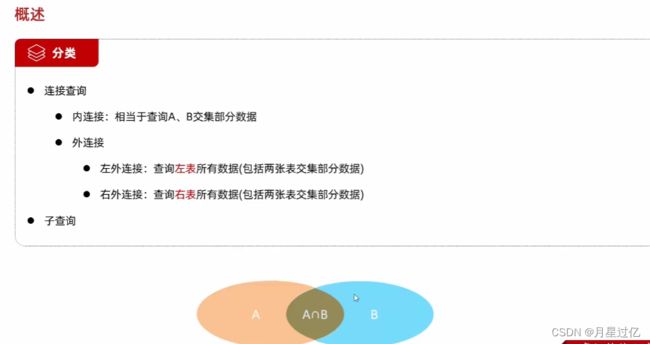
1.内连接
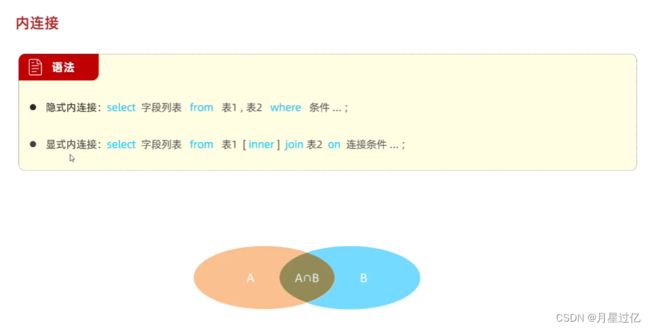
select tb_emp.name,tb_dept.name from tb_emp,tb_dept where tb_emp.dept_id=tb_dept.id;
select tb_emp.name,tb_dept.name from tb_emp inner join tb_dept on tb_emp.dept_id=tb_dept.id;
select e.name,d.name from tb_emp as e,tb_dept as d where e.dept_id=d.id;
select e.name,d.name from tb_emp as e inner join tb_dept as d on e.dept_id=d.id;
2.外连接
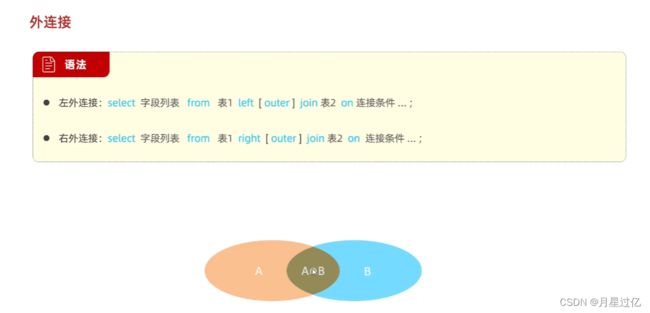
select e.name,d.name from tb_emp e left join tb_dept d on e.dept_id=d.id;
select d.name,e.name from tb_dept d right join tb_emp e on d.id=e.dept_id;
3.子查询

1.标量子查询

-- 标量子查询
-- A 查询 “教研部” 的所有员工信息
-- a.查询 教研部 的部门ID -tb_dept
select id from tb_dept where name='教研部';
-- b 再查询该部门ID下的员工信息
select * from db04.tb_emp where dept_id=2;
select * from db04.tb_emp where dept_id =(select id from tb_dept where name='教研部');
-- 查询在“方东白”入职之后的员工信息
select entrydate from db04.tb_emp where name='方东白';
select * from db04.tb_emp where entrydate>'2012-11-01';
select * from db04.tb_emp where entrydate>(select entrydate from db04.tb_emp where name='方东白');
2.列子查询

-- 列子查询
-- A 查询 教研部 和 咨询部 的所有员工信息
-- a 查询 教研部 和 咨询部的部门ID
select id from tb_dept where name='教研部' or name='咨询部';
-- b 根据部门ID 查询该部门下的员工信息
select * from db04.tb_emp where dept_id in (2,3);
select * from db04.tb_emp where dept_id in (select id from tb_dept where name='教研部' or name='咨询部');
3.行子查询

-- 行子查询
-- A.查询与“韦一笑”的入职日期 及 职位都相同的员工信息
-- a.查询“韦一笑”的入职日期及职位
select entrydate,job from db04.tb_emp where name='韦一笑';
-- b 查询与其入职日期及职位都相同的员工信息;
select * from db04.tb_emp where entrydate='2007-01-01' and job=2;
select * from db04.tb_emp where (entrydate,job)=('2007-01-01',2);
select * from db04.tb_emp where (entrydate,job)=(select entrydate,job from db04.tb_emp where name='韦一笑');
4.表子查询

-- 表子查询
-- A. 查询入职日期是 2006-01-01 之后的员工信息,及其部门名称
-- a. 查询入职日期是 2006-01-01 之后的员工信息
select * from db04.tb_emp where entrydate>'2006-01-01';
-- b.查询这部分的员工信息及部门名称
select e.*,d.name from (select * from db04.tb_emp where entrydate>'2006-01-01') e ,tb_dept d where e.dept_id=d.id;
4.案例

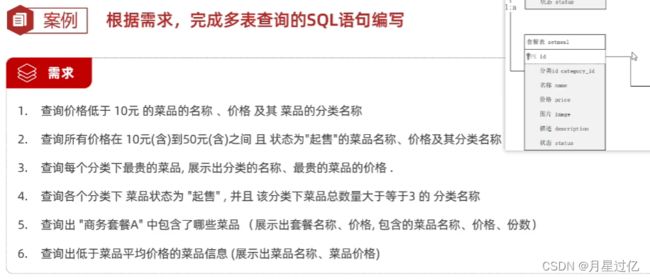
select d.name,d.price,c.name
from dish d ,category c
where d.category_id=c.id and d.price<10;
select d.name,d.price,c.name
from dish d left join category c
on d.category_id = c.id where d.price >=10 and d.price<50 and d.status=1;
select c.name,max(price)
from dish d ,category c
where d.category_id=c.id
group by c.name;
select c.name,count(*) as c2
from dish d ,category c
where d.category_id=c.id and d.status=1
group by c.name having c2>3;
select s.name,s.price,d.name,d.price,sd.copies
from setmeal s,setmeal_dish sd,dish d
where s.id=sd.setmeal_id and sd.dish_id=d.id and s.name='商务套餐A';
select avg(price)from dish;
select name ,price from dish where price <(select avg(price)from dish);
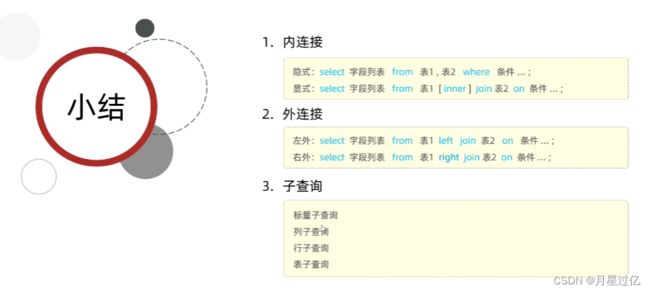
八、事务
1.介绍&操作


-- 开启事务
start transaction ;
-- 删除部门
delete from tb_dept where id=2;
-- 删除该 部门下的员工
delete from db04.tb_emp where id=2;
-- 提交事务
commit ;
-- 回滚事务
rollback ;
2.事务的特性


九、mySql索引
1.介绍&优缺点
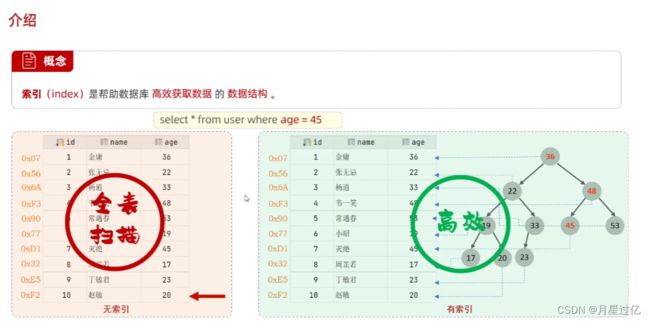

2.结构
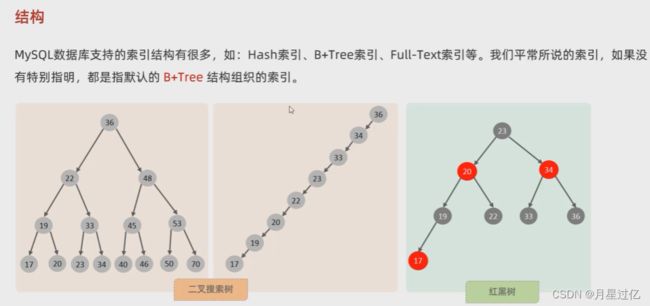

3.语法

-- 创建 :为表的name字段建立一个索引
create index idx_emp_name on tb_emp(name);
-- 查询 : 查询 表的索引信息
show index from db_03.tb_emp;
-- 删除 删除 name 字段的索引
drop index idx_emp_name on db_03.tb_emp;
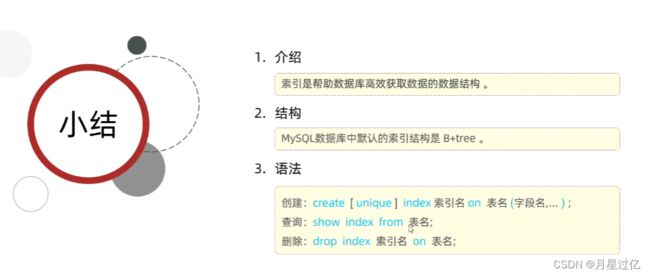
![]()
























































